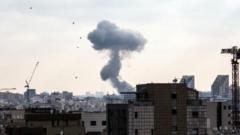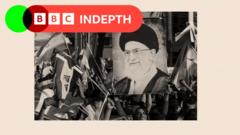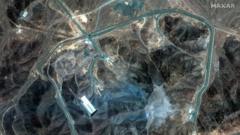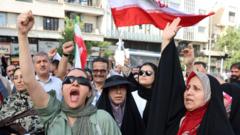**As the conflict escalates, Iran must choose whether to retaliate now, later, or pursue a path of restraint and negotiation.**
**Iran's Strategic Crossroads: Potential Responses to U.S. Strikes**

**Iran's Strategic Crossroads: Potential Responses to U.S. Strikes**
**Amid rising tensions, Iran faces critical options following recent U.S. airstrikes on its nuclear sites.**
In the wake of recent U.S. airstrikes targeting three of its nuclear facilities, Iran finds itself at a pivotal junction, having vowed to impose "everlasting consequences." The high-stakes discourse within Iran's security and intelligence circles is intense, with key figures weighing whether to escalate military conflicts or heed U.S. calls for negotiations that would essentially necessitate the abandonment of Iran’s nuclear enrichment pursuits.
This internal struggle occurs amidst a backdrop of trepidation, with Iranian commanders cautious of potential Israeli airstrikes and possible infiltration by foreign intelligence agencies, such as Mossad. As tensions flare, Iran's decision makers are scrutinizing three principal strategies, each fraught with risks that could threaten the Islamic Republic's survival.
**The Immediate Retaliation Option**
For many within the Iranian military establishment, the imperative to retaliate quickly against perceived aggressors is compelling. The ongoing missile exchanges with Israel have created a sense of humiliation, compounded by recent U.S. actions. However, retaliating against U.S. interests carries heightened risks—not only for Iran but for regional stability as well. While Iran still possesses a considerable missile arsenal—estimated at around 1,500 operational missiles—targeting U.S. bases could prove precarious.
Iran could potentially choose from several U.S. bases, among them the strategic naval headquarters in Bahrain or remote installations in Iraq and Syria, which may be less fortified. Furthermore, there is the option of deploying 'swarm attacks' via drones or speedboats against U.S. naval vessels to exploit numerical advantages, as practiced by the Revolutionary Guards. Iran could also revive its proxy networks in Yemen to mount disruptive actions on maritime routes crucial for international commerce.
Economic targets serve as an additional avenue for Iranian retaliation, yet striking these would alienate Gulf allies who have recently maintained a cautious peace with Iran. An ambush on the vital Strait of Hormuz, a crucial global oil passage, poses the most significant threat, as mines deployed in the water could disrupt global energy supplies. Cyberattacks against U.S. infrastructure might also feature in Iran's strategic calculus.
**Retaliation at a Later Stage**
Alternatively, Iran may opt for a delayed reaction by choosing to lie low until the tensions subside. This strategy would involve launching a surprise attack when U.S. forces are less vigilant, or targeting diplomatic entities and individuals of significance. However, the risk associated with this approach remains high; an unprovoked strike could reinvigorate U.S. military responses just as life in Iran begins to normalize post-crisis.
**Choosing Restraint and Negotiation**
A more tempered approach would see Iran displaying restraint, forgoing immediate retaliation to avoid further U.S. strikes while engaging in dialogue for a potential diplomatic resolution. This route involves recalibrating its stance while navigating pre-existing complexities in U.S.-Iran relationships. Iran's foreign minister noted that the country had not abandoned negotiations, attributing disruptions to the actions of the U.S. and Israel.
However, such restraint could invite perceptions of weakness, adapting Iran's narrative after expressing severe retaliation threats. Ultimately, Iran's leadership must balance preserving authority and addressing internal and external pressures against the backdrop of conflict. The path they choose will profoundly impact the future dynamics of U.S.-Iran relations and regional stability.






















